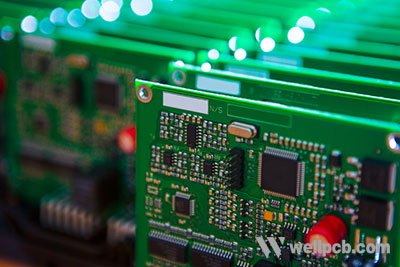Contents
Implement Design For Fast Manufacturing (DFM)
PCB design for manufacturing (DFM) aims to improve the manufacturability of PCBs during their design stage. Sometimes, the PCB design you want is difficult or impossible to manufacture, so the manufacturer sends it to you for a redesign. Sometimes, the manufacturer attempts its restructuring. This process slows down the turnaround time.
The solution is to implement DFM. Take your PCB manufacturer’s capabilities and documentation requirements while you’re still in the design stage to avoid potential redesigns. Consultation with the manufacturer during this phase plays a significant role in ensuring manufacturability. Be sure to place fiducial markers to help in automating pick-an-place machines.
 PCB assembly.jpg” title=”Multiplied printed circuit boards PCB isolated on the white background. PCB assembly”/>
PCB assembly.jpg” title=”Multiplied printed circuit boards PCB isolated on the white background. PCB assembly”/>Source Components Yourself
One of the top causes of delays in PCBs is when an essential component runs out of stock when the manufacturer needs it. Usually, this happens between creating the bill of materials (BOM) and placing the fabrication order. The best way to avoid this situation is through careful planning and sourcing. Try to avoid last-minute changes in your supply chain, as this could lead to longer lead times.
Rather than depending on your PCB manufacturer to source components for you, consider doing that independently. Sure, a fast PCB manufacturer may have an excellent relationship with several PCB component distributors, but they’re sometimes vulnerable to a shortage of parts. The last thing you want is for your manufacturer to redesign your board because they don’t have a particular region. You can’t have the guarantee that the redesigned PCB will accurately meet your requirements. If the product is defective, the turnaround time will inevitably increase.

Provide a Complete Documentation Package
For fast correct PCB service provider. Thankfully, there are various PCB manufacturing, a PCB company will require a complete document that includes the following:
- Gerber files
- Drill files
- A total bill of materials
- A netlist file
- Your raw CAD files
- Centroid data
- Assembly instructions
- Assembly drawings
When you fail to send centroid data to your PCB manufacturer, chances are the manufacturing process will be delayed. That’s because this data provides the specific details of the component orientation. Centroid data also links individual components to their reference designators. Without this essential data, your manufacturer will have to try to figure out crucial details on their own, which slows down the entire process.

Simplify Your Designs
The vast majority of modern circuit boards have multiple layers. These boards require many fabrication steps for every layer, which takes a considerable amount of time. If you can reduce this layer count, you’ll eliminate all the unnecessary and time-consuming fabrication steps and decrease the PCB turnaround time.
The most uncomplicated PCB design involves two layers. Two-layer PCBs typically require a smaller number of pressing, etching, plating, and overlay steps. To reduce layer counts, you’ll need to remove through-hole vias and opt for blind and buried vias.
You can decide to adopt a layer stack design and routing, which eliminates some layers. That will add to the plating steps, but you get to reduce the fabrication steps.

Adopt Advanced Technology And Systematic Processes
Over the years, there’s been rapid innovation in the PCB manufacturing field. With advancing technology, there’s a massive improvement in many aspects of the PCB manufacturing process. These include:
1. Higher responsiveness to the demands of customers
2. Lower downtime and waste levels
3. Better product design and quality
4. Streamlined relationships between suppliers and customers
5. Enhanced customer service delivery
Each of the improvements above contributes to faster turnaround times. Any business that invests in new technologies will generally compete better and thrive more in today’s market. When looking for a fast PCB manufacturer, consider those who prioritize advanced technology in their processes.

Consider Compliance
The most reliable PCB manufacturers ensure that they’re compliant with the highest industry standards. A PCB manufacturer should be able to provide high quality in every step of the manufacturing process. Each phase of PCB production requires careful attention.
Find out if your prospective PCB manufacturer adheres to all standards from the Institute for Printed Circuits, for instance. Do they provide their customers with PCBs that adhere to RoHS, ISO, and UL codes?
Only a PCB manufacturer who sticks to industry standards can guarantee that their products are safe, reliable, and high-performing. And since adhering to industry standards and codes improves communication both internally and externally, the manufacturing process is generally much faster.
Companies that do not comply with the relevant codes, on the other hand, will usually experience production delays. That’s because the final product will often fail to meet the standards you expect, which calls for redesigning.

Conclusion
In summary, time is a vital factor when it comes to producing PCBs. You must put in place activities that can help you save time when it comes to PCB manufacturing. One of the best moves is to partner with a PCB manufacturer who goes out of their way to ensure that you get your PCBs on time. Such a manufacturer will usually carry out the whole process of PCB fabrication through a quick turnaround time frame.
If you’re looking for a PCB manufacturer who can guarantee the best quality PCBs within the shortest time possible, talk to WellPCB today. We manufacture all our printed circuit boards in-house, so we have full control of the entire Contact us today for more information on our customized solutions.





